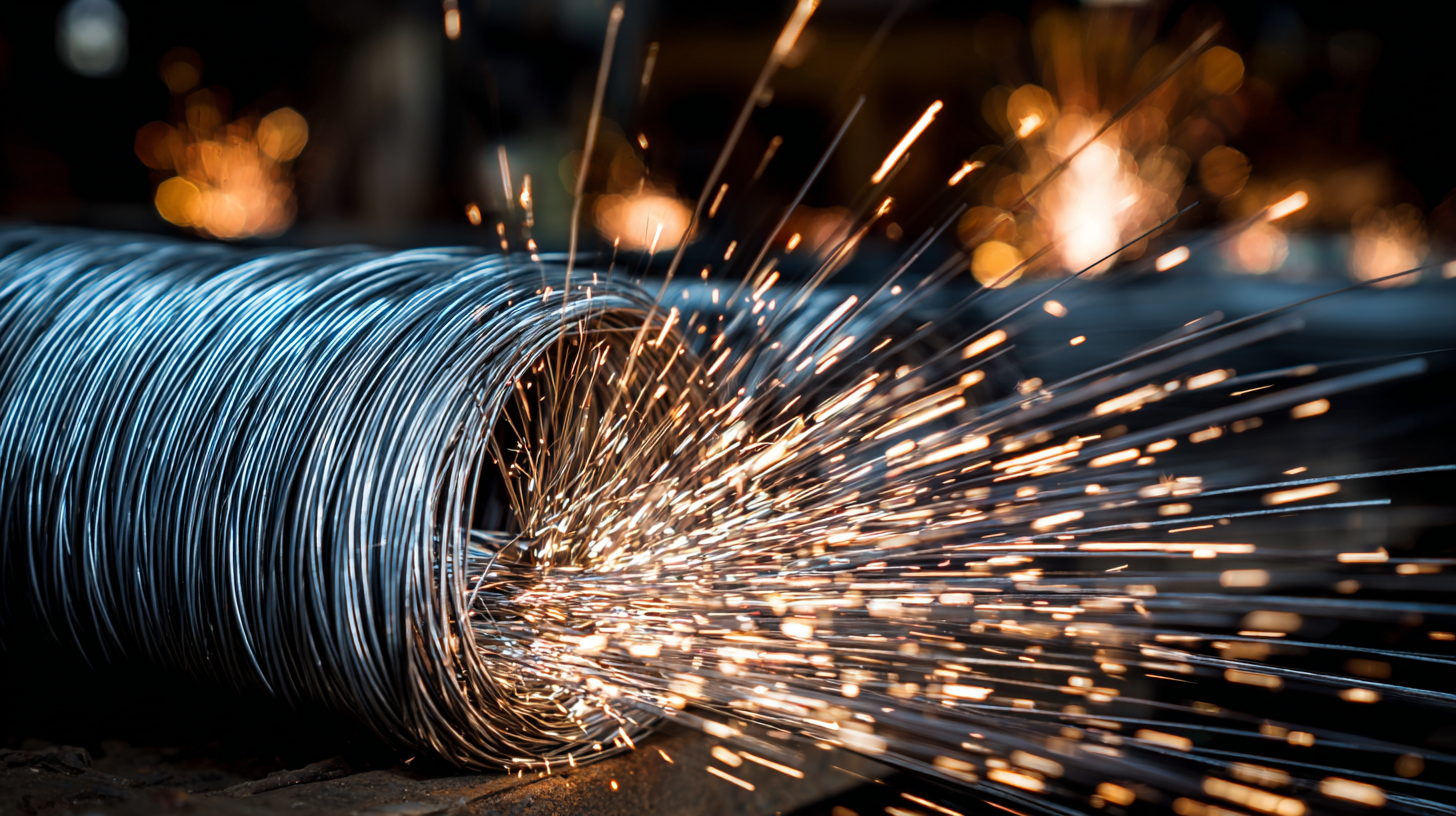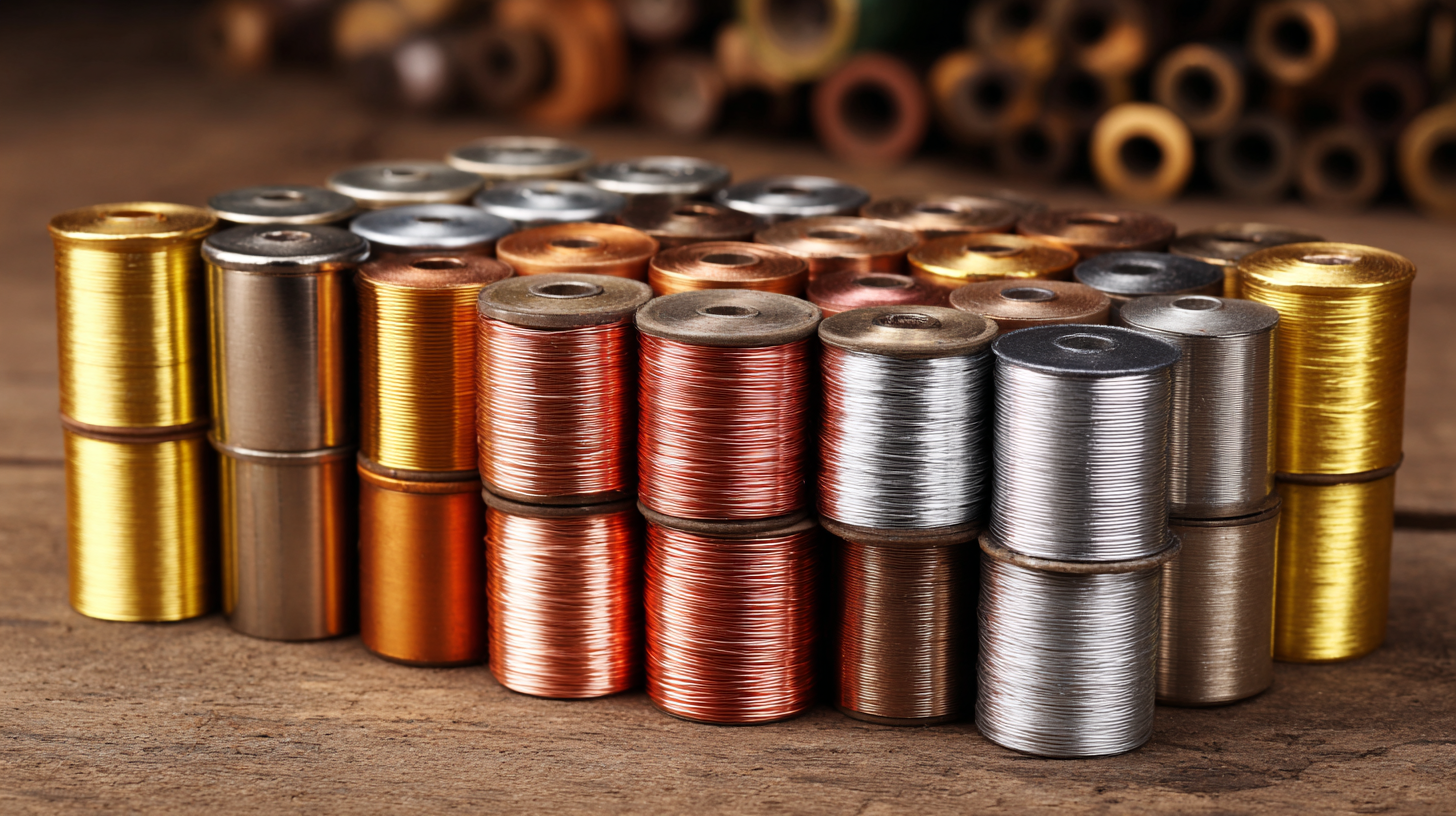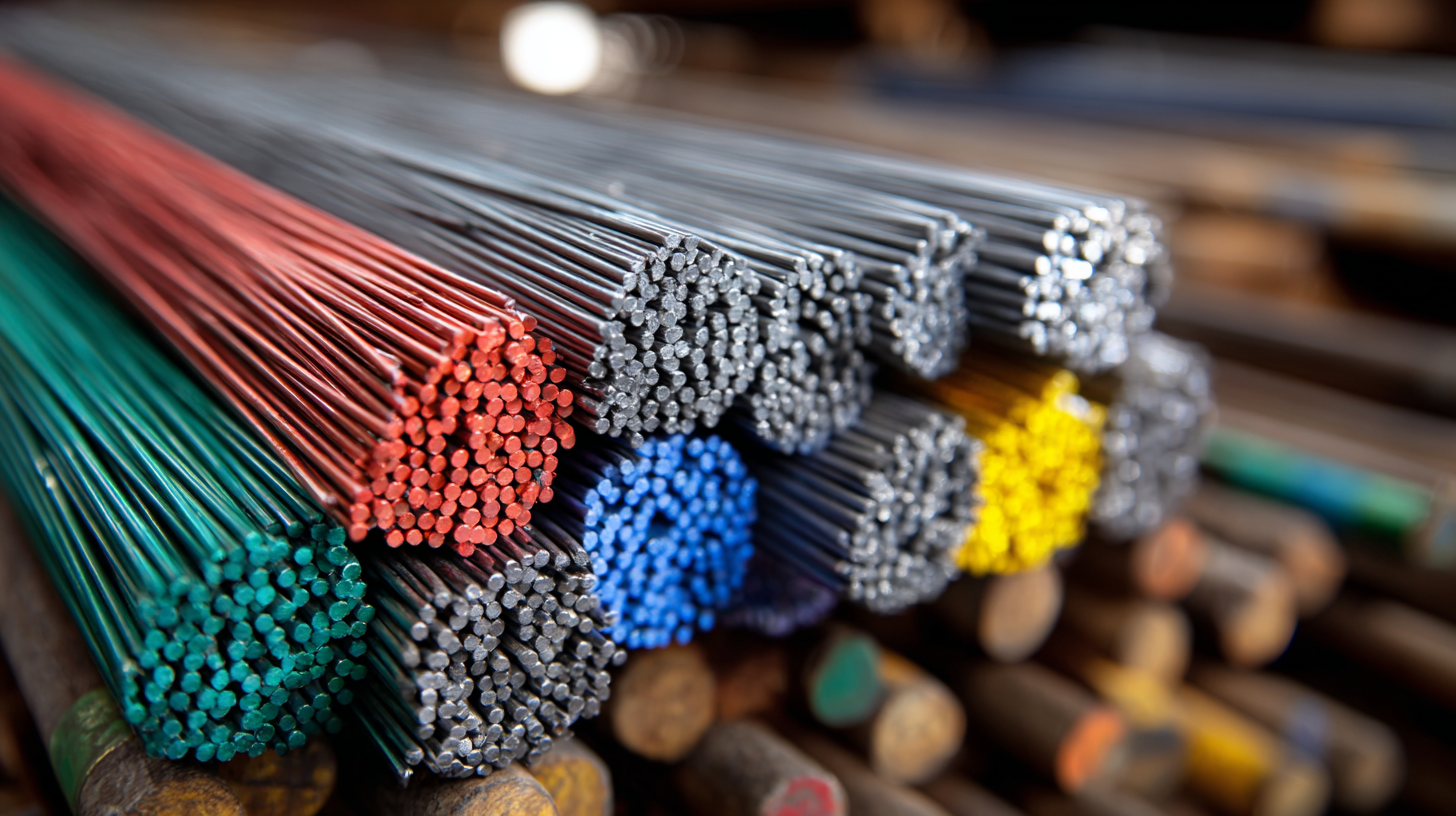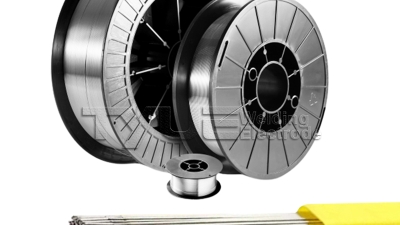15 Essential Tips for Choosing the Best Mig Welding Wires
Table of Contents
- Understanding the Different Types of MIG Welding Wires
- Key Factors to Consider When Selecting MIG Welding Wire
- How Wire Diameter Affects Your Welding Performance
- The Importance of Wire Composition in MIG Welding
- Evaluating the Right Coating for Your MIG Welding Needs
- Cost vs. Quality: Making Informed Choices for Welding Wire
- Essential Guide to ER316H Stainless Steel Welding Wire: Applications, Benefits, and Best Practices
- FAQS
- Conclusion
- Related Posts
When it comes to welding, picking the right materials is pretty important if you want those results to be top-notch. MIG welding wires, for example, really make a difference—not just in how strong your welds turn out, but also how good they look. I’ve seen reports that say the global market for welding supplies is expected to hit around $41 billion by 2027. And that’s mainly because more industries—think auto manufacturing and construction—are demanding reliable, durable welding solutions. I’ve been in this game for over 22 years, and I can tell you, Wenzhou Tianyu Electronic Co., Ltd. has been doing a fantastic job producing quality welding electrodes and consumables, especially stainless and carbon steel wires. Choosing the right MIG wire isn’t just about making your work easier; it’s about making sure your projects last and stand the test of time. In this blog, I’ll share 15 key tips to help you pick the best MIG wires. Trust me, it’ll make a difference in your welding game!

Understanding the Different Types of MIG Welding Wires
When you're diving into MIG welding, choosing the right welding wire really matters if you want strong, high-quality welds. Honestly, getting to know the different types of wires out there can make a big difference. Basically, there are two main kinds: solid wires and flux-cored wires. Solid wires are usually used with shielding gas — they give you clean welds with hardly any spatter. They’re especially good if you’re working with thin materials. On the flip side, flux-cored wires are self-shielding, meaning you don’t always need extra gas, which makes them awesome for outdoor jobs or when you’re dealing with thicker stuff in windy conditions. The American Welding Society even says that picking the right wire can seriously impact your weld quality and overall efficiency — like, it could boost your productivity by up to 30%. Pretty wild, right?
And here’s the thing — the materials used in these wires can really change how they perform. For example, ER70S-6 is a common choice for mild steel because it offers great mechanical properties, while ER308L is typically used for stainless steel projects. A study in the Journal of Materials Processing Technology pointed out that choosing the right wire doesn’t just make your welds stronger — it can also save you money in the long run. Using higher-quality wires might cut repair costs by nearly 20% because there are fewer defects overall. Knowing these differences helps you pick the perfect wire for your specific project, so you get the best quality without wasting time or money.
Key Factors to Consider When Selecting MIG Welding Wire
When you're trying to pick the best MIG welding wire, there are a few key things you really should keep in mind—because they can make a big difference in how your weld turns out. First off, the type of wire matters. You’ve got your options like solid wire, flux-cored wire, and metal-cored wire. For instance, solid wires work great on thinner, cleaner materials and tend to produce less spatter, which is always a plus. On the other hand, flux-cored wires are often better if you’re working on thicker stuff or doing outdoor welding—especially when wind might blow away your shielding gas.

Another thing to pay attention to is the diameter of the wire. It’s usually best to match that to the thickness of the material you’re welding. If you're working with light, thin metals, a smaller wire is usually easier to control and gives you better precision. Plus, knowing which welding technique you'll be using—like short circuit, spray transfer, or pulse—really helps in picking the right wire. Each of these methods has its own quirks and requirements, so choosing the right wire can seriously boost your efficiency and the quality of your welds.
And of course, double-check that the wire works with your welding machine and suits what you’re trying to achieve; that way, you’re set for the best possible results.
How Wire Diameter Affects Your Welding Performance
When you're diving into MIG welding, the wire diameter you pick really matters—it can make a big difference in how your weld turns out. According to the folks at the American Welding Society (AWS), smaller wires tend to give you better control and less distortion, especially when working with thinner materials. Usually, wires in the 0.023 to 0.030 inch range work great for thinner gauges—they help keep things steady and neat. On the flip side, if you're dealing with thicker, heavier stuff, a wire in the 0.035 to 0.045 inch range is the way to go. It allows for deeper penetration and more filler material, making sure your weld is solid.
Industry data from the Welding Equipment Manufacturers Committee (WEMC) also shows that choosing the right wire size isn't just about control—it's about efficiency too. For example, a 0.030-inch wire can give you a pretty good deposition rate of around 4-6 pounds per hour, which is awesome if you're trying to get things done faster without losing quality. But heads up—using a thicker wire on thin material can lead to overheating or even burn-through spots. So, getting the hang of how wire size impacts your results really pays off in making your welds look good and hold strong, no matter what you're working on.
Wire Diameter vs Welding Performance
The Importance of Wire Composition in MIG Welding
When you’re working with MIG welding, the kind of welding wire you choose really makes a big difference in how strong and high-quality your welds turn out. The wire’s composition mainly affects things like how tough the weld bead is and how well it can bend without breaking. According to the American Welding Society, wires that have more deoxidizers like silicon and manganese tend to give you cleaner welds with better fusion. So, picking the right wire with the right mix should definitely be a top priority.
One of the best tips I can share is to match your wire to the material you’re welding. For example, ER70S-6 is a popular option for carbon steel because it has higher silicon and manganese levels, which help it perform better in places where oxidation can be an issue. Also, don’t forget about the wire diameter—thicker wires deliver more heat but can be tricky to control if you’re doing detailed work, while thinner wires are usually better for lighter or thinner materials. Making smart choices based on the wire’s composition and your project needs can really make a difference in the final result.
And here’s another thing—think about what the job requires. If you need a super clean weld, especially in critical situations, it’s better to go with gas-shielded wires that won’t introduce contamination. Recent studies show that using wires with the right alloying elements can cut down on defects by up to 40%, which is a pretty huge deal for weld quality. Basically, by paying attention to the wire’s composition and what your specific application demands, you’re much more likely to get those killer welds you’re aiming for.
15 Essential Tips for Choosing the Best Mig Welding Wires - The Importance of Wire Composition in MIG Welding
| Wire Type | Composition | Diameter (mm) | Applications | Recommended Gas |
|---|---|---|---|---|
| ER70S-6 | Iron, Carbon, Manganese | 0.8 | General Steel Welding | Argon-CO2 Mix |
| ER70S-3 | Iron, Manganese, Silicon | 0.9 | Structural Steel Welding | CO2 |
| ER308L | Nickel, Chromium, Molybdenum | 1.0 | Stainless Steel Welding | Argon |
| ER5356 | Aluminum, Magnesium | 1.2 | Aluminum Welding | Argon |
| ER70S-4 | Iron, Carbon, Manganese | 1.0 | High-Strength Steel | Argon-CO2 Mix |
Evaluating the Right Coating for Your MIG Welding Needs
When you're choosing the best MIG welding wires, one thing you really don't want to overlook is the coating. It might seem like a small detail, but the type of coating can really make a difference in how the welding turns out and how sturdy the final product is. For example, recent research shows that certain surface coatings can boost wear resistance and help fight off corrosion. This isn’t just for everyday welding—it's even more crucial in specialized projects, like tunnel boring machines, where nickel-based coatings are used to make cutter rings last longer.

Besides coatings, it’s also super important to look at the chemical makeup and mechanical properties of the welding wires themselves. Take polysilazane-derived SiON coatings, for example—they’ve been proven to significantly improve corrosion resistance on stainless steel welds. Incorporating these advanced materials into your welding routine can really level up your results. Overall, focusing on the right coating isn’t just a small detail, it’s key to making sure your work stands the test of time and the elements.
Cost vs. Quality: Making Informed Choices for Welding Wire
When you're choosing the best MIG welding wires, it’s really important to find that sweet spot between cost and quality. Sure, high-quality wires can be pricier, but they often make a huge difference in how strong and durable your welds turn out. On the flip side, going for cheaper options might seem tempting at first, but those lower-quality wires can cause inconsistent welds and mean more rework later on — which? Ends up costing you more in the end.
One tip I always keep in mind is to check out what the chemical makeup of the wires is. Different jobs call for different types of wires. For example, flux-cored wires are pretty much your go-to for outdoor welding, since they can handle the wind better. Meanwhile, solid wires are great for indoor projects, giving you a cleaner finish. Taking a moment to think about exactly what your project needs can really help you choose something that's both good quality and within your budget.
And don’t forget—before you buy, it’s worth reading reviews on welding machines and wires. The latest models often have pretty impressive features and are versatile enough to handle different materials. Paying attention to these little details makes a big difference in both how smoothly your welding goes and how the final result turns out. Trust me, a bit of research can save you headaches down the line.
Essential Guide to ER316H Stainless Steel Welding Wire: Applications, Benefits, and Best Practices
When it comes to stainless steel welding, ER316H welding wire stands out as a premier choice due to its remarkable cladding efficiency and superior technical performance. This type of welding wire is specially designed for all-position welding, making it versatile for various applications. The inherent qualities of ER316H ensure that welds are not only strong but also resistant to corrosion, which is crucial in harsh environments.
In industry, ER316H stainless steel welding wire finds extensive use across multiple sectors. It is integral to building structures, where its durability is paramount. Additionally, its applications extend to vehicle manufacturing, bridge engineering, and mining machinery, showcasing its reliability. The oil and gas sectors also benefit from using this welding wire, particularly in pressure-bearing equipment and pipelines, where safety and performance are critical. With its ability to deliver high-quality welds consistently, ER316H welding wire is a go-to solution for engineers and manufacturers looking for reliability and efficiency in their welding processes.
FAQS
: The two primary categories of MIG welding wires are solid wires and flux-cored wires.
Solid wires provide clean welds with minimal spatter and are ideal for applications involving thin materials when used with a shielding gas.
Flux-cored wires are self-shielding and can be used outdoors, making them suitable for thicker materials and windy conditions.
Selecting the proper welding wire can influence weld quality and efficiency, potentially impacting productivity by up to 30%.
The composition of MIG welding wires affects mechanical properties like tensile strength and ductility, ultimately influencing the quality of the weld.
Matching the wire to the base material ensures better performance; for instance, ER70S-6 is recommended for carbon steel due to its enhanced oxidation resistance.
Thicker wires deliver more heat but may be harder to control for precision work, while thinner wires are better suited for lighter materials.
Assessing specific application requirements and using wires with suitable alloying elements can reduce defects by up to 40%, significantly enhancing weld integrity.
Common materials include ER70S-6 for mild steel and ER308L for stainless steel applications.
High-end wires can reduce repair costs by nearly 20% due to fewer defects, making them a cost-efficient choice for projects.
Conclusion
When you're trying to pick out the best MIG welding wires, it’s pretty important to get a good grasp of the different types out there. There are quite a few options, with varying compositions and diameters, each suited for specific materials and projects. For example, the wire’s thickness can really make a difference in how well your weld turns out, and the composition plays a big role in kinda ensuring the weld looks good and holds up. Oh, and don’t forget about the coating on those wires—this tiny detail can actually make your welding smoother by helping feed the wire better and keeping the arc stable.
Here at Wenzhou Tianyu Electronic Co., Ltd., we’ve been around for over 20 years, making top-notch welding consumables, including MIG wires. Choosing between cost and quality is a bit of a balancing act, but it’s super important because it can really impact how your project turns out. So, if you keep these tips in mind, you'll be on the right track to picking the perfect MIG welding wires that suit your needs and help you get great results every time.
Related Posts
-

Innovative Advancements in Wire Weld Technology and Its Advantages in 2025
-

Unlocking Global Trade Opportunities at the 2025 Canton Fair with Aluminum Wire Innovations
-

Emerging Trends in Stick Welding Stainless Steel for 2025 A Comprehensive Guide for Global Buyers
-

2025 Welding Innovations: The Top 5 Best Rods to Elevate Your Projects
-

Mastering Hard Facing Techniques with the Best Hard Facing Welding Rods for Superior Durability
-

Unlocking the Future of Best Welding Brass With Tig Strategies for Global Buyers in 2025
Blog Tags:


